[1]
Zhang Houzhu, Zhang Yu, Sun Zheng, Implicit splitting finite difference Scheme for numerical simulation of multi-dimensional Wave equation, Geophysical Prospecting for Petroleum, Vol. 46(2007) , p.594–597.
Google Scholar
[2]
Zhijie Yuan, The Research on the Computing Problems and the Properties about Special Matrices, Northwestern Polytechnical University Master's Thesis (2005).
Google Scholar
[3]
Jingliang Chen, Xianghui Chen, Special Matrix, Tsinghua University Press(2001).
Google Scholar
[4]
Zhong Xiu, Kaiyuan Zhang, Quan Lu, Fast algorithm for Toeplitz matrix, Northwestern Polytechnical University Press(1999).
Google Scholar
[5]
R. Peluso,T. Politi, Some improvements for two-sided bounds on the inverse of diagonally dominant tridiagonal matrices, Linear Algebra Appl., Vol. 330(2001) , p.1–14.
DOI: 10.1016/s0024-3795(01)00254-3
Google Scholar
[6]
XiaoQin Liu, TingZhu Huang, Ying-Ding Fu, Estimates for the inverse elements of tridiagonal matrices, Applied Mathematics Letters, Vol. 19(2006)4, p.590–598.
DOI: 10.1016/j.aml.2005.08.009
Google Scholar
[7]
D. Kershaw, Inequalities on the elements of the inverse of a certain tridiagonal matrix, Math. Comput. Vol. 24(1970), p.155–158.
DOI: 10.1090/s0025-5718-1970-0258260-5
Google Scholar
[8]
R. Nabben , Two-sided bounds on the inverse of diagonally dominant tridiagonal matrices, Linear Algebr. Appl., Vol. 287(1999) , p.289–305.
DOI: 10.1016/s0024-3795(98)10146-5
Google Scholar
[9]
YANG Chuan-sheng, YANG Shang-jun, Closure Properties of Inverse M-matrices under Hadamard Product, Journal of Anhui University(Natural Sciences), Vol. 4(2000) , pp.15-20.
Google Scholar
[10]
LOU Xu-yang CUI Bao-tong, Exponential dissipativity of Cohen-Grossberg neural networks with mixed delays and reaction-diffusion terms, Vol. 4(2008), pp.619-922.
Google Scholar
[11]
GUO Xi-juan, JI Nai-hua, YAO Hui-ping, The Judgement and Parallel Algorithm for Inverse M-matrixes , Journal of Beihua University, Vol. 45(2004), pp.97-103.
Google Scholar
[12]
YANG zhong-yuan,FU Ying-ding,and HuANG Ting-zhu, Some Properties of InverseM-Matrices and Their Applications, Joumal of UEST of China Vol. 34(2005), pp.713-716.
Google Scholar
[13]
HAN Yin, The Property and Judgment of Inverse M-Matrixes, Journal of Huzhou Teachers College, Vol. 30(2008), pp.10-12.
Google Scholar
[14]
You Zhaoyong, Nonsingular M-matrix[M]. Wuhan: Huazhong University of Science and Technology Publishing House, (1983).
Google Scholar
[15]
Zhaolin Jiang, Non singularity on scaled factor circulant matrices, Journal of Baoji College of Arts and Science (Natural Science, 23 (2003) 5-7.
Google Scholar


